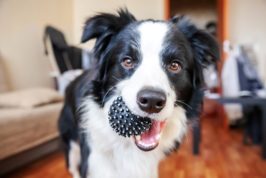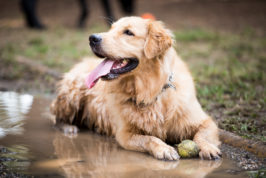How to clean your pets’ teeth
A whopping 80% of cats and dogs will experience some kind of dental disease before they turn four. It’s a worrying statistic, and one that could reduce if we commit to taking proper care of our pets’ teeth cleaning.
Your pet’s dental health contributes to its overall health. That means the teeth should be looked after in the same way as any other part of the body. If dental issues arise and are left untreated, this can lead to serious complications later down the line, so it pays to stay on top of things.
Interesting facts about our pets’ teeth
- Cats and dogs are born without teeth, and develop a set of baby teeth around the three-week mark. These baby teeth will loosen and fall out to make way for adult teeth, just like humans
- Cats and dogs’ adult teeth usually come in at around six months
- Adult dogs have 42 teeth, while adult cats have just 30 (humans sit in the middle, with 32 pearly whites)
- Cats and dogs have similarly shaped teeth. The fangs are in place thanks to their carnivore nature, and would allow them to hunt prey successfully in the wild
- The enamel coating on cats and dogs’ teeth is weaker than humans, so they’re more prone to fractures and breakages
- Gum disease is the most common dental problem for adult cats and dogs
Signs of dental issues in cats and dogs
The following could signal there’s a problem…
- Pain or discomfort
Your pet may appear to swipe or paw at the mouth area - Fractured or missing teeth
If you spot any gaps or dents, it’s time to see the vet - Change in eating habits
Gums or teeth that are sore may result in your cat or dog eating less than usual - Change in mood
Your pet might seem depressed, anxious or irritable - Gingivitis
Redness along the gum line points to Gingivitis – inflammation of the gums - Tartar
This is a yellow or brown substance that forms when plaque has hardened on the teeth - Odour
Tartar build-up rots the teeth and gums, which causes rotten breath
Why should I clean my pet’s teeth?

It’s a common misconception that we can leave our pets’ teeth alone, as their dental health looks after itself – just like in the wild. The problem is, domestic pets live very different lives to animals in the wild, and their teeth won’t experience the same kind of treatment.
If domestic pets develop dental issues that aren’t treated properly in the long-term, bacteria can get into the bloodstream and affect vital organs such as the heart and kidneys.
Pet teeth cleaning at the vets
If you choose not to clean your pet’s teeth at home, most vets recommend an annual ‘dental’. This is a thorough clean, descale and polish, and it’s done under general anaesthetic. You’ll pay between £150 and £600 for the procedure – it all depends on your vet and whether or not any teeth need removing, which naturally ups the cost.
Pet teeth cleaning products
You’ll find plenty of teeth cleaning products on the shelves in your local pet store. Things like dental chews, water additives, cleansing seaweed extracts – the list goes on. The fact is, none are as effective at promoting healthy teeth and gums as proper brushing. Dental chews, for example, may go some way to keeping your dog’s back teeth clean, but they won’t get to the rest (not to mention this is an extra calorie intake).
All you need to brush your pet’s teeth is a pet tooth polish and a soft bristled toothbrush. The former comes in flavours an animal would find appealing, too, such as liver. If your pet really won’t go for a toothbrush, consider dental wipes and dental sprays – there’s a huge selection to choose from. Be sure to get your annual dental in, too.
Dental care for cats and dogs
- Never substitute pet toothpaste human toothpaste – it’s packed with artificial sweeteners and contains fluoride, which can be toxic to animals
- Be gentle! It’s important to clean your pet’s teeth carefully to avoid causing distress
- Stay calm and have patience. Talk to your pet in a soothing manner. If you’re rushing and stressed out, they will notice the atmosphere and respond accordingly!
- Don’t just rely on vet dentals – you should still be caring for your pet’s teeth in between
- Use a pet toothbrush specifically designed for their teeth, or go for an antibacterial tooth cleaner
- Introduce teeth cleaning with your pet from a young age – it’ll become a normal part of their routine
- Don’t give up! If your dog or cat is already an adult and you’ve never attempted cleaning their teeth, it’s not too late
Cleaning your pets’ teeth: a step-by-step guide
The following is a general guide for cleaning your cat or dog’s teeth. It’s a good idea to check in with your veterinary nurse or pet groomer for a lesson first. Dogs, in particular, may need extra attention. Those with pointy muzzles or small mouths are more susceptible to dental issues, so we’d recommend getting expert advice upfront.
- Start by regularly adding a little pet toothpaste to your pet’s food – it’s a good way of getting them used to the taste, before you start brushing
- Leave it a few days, then pop some toothpaste on your finger and encourage your pet to sniff or lick it off
- The next step is to try the brushing motion with just a finger and some toothpaste, to help your pet get used to the sensation
- Now your pet’s ready for a proper toothbrush! Lift the upper lip and use gentle, circular motions to brush the teeth and gumline. Repeat with the lower lip and teeth.
You’re done! As for how often you should be cleaning your pets’ teeth? Generally speaking, it’s best to do it two to three times a week, but this will vary depending on the animal.




